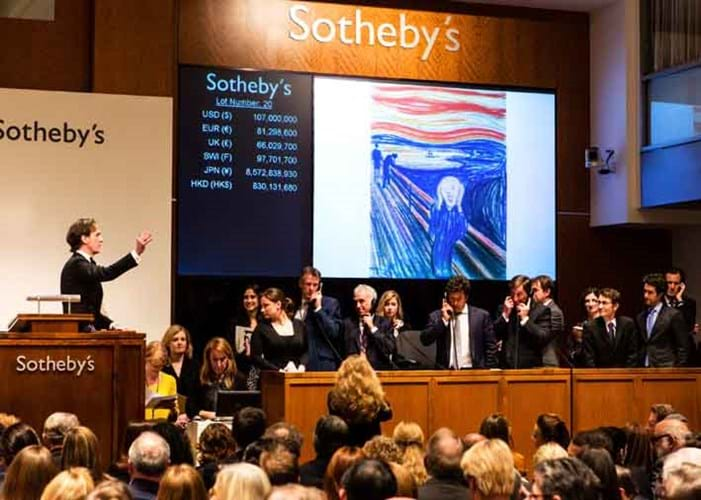
The premium-inclusive $119.9m it took in New York on May 2 accounted for almost 5% of the company's entire $2.44bn (£1.53bn) auction total for the first half of 2012.
At $2.99bn (£1.88bn), Sotheby's consolidated sales total was significantly below the $3.5bn (£2.2bn) announced by arch rivals Christie's for the same period.
While Sotheby's auction sales have fallen, however, the hotly competed private sales sector has surged, with Sotheby's reporting a 15% increase for the period to $513.6m, adding $40m to company revenues. By comparison, private sales contributed $661.5m (£416m) to Christie's headline total, an increase of 53%.
Although, as usual, Christie's did not reveal how much of that sum was actual company turnover, the latest figures mean that private transactions now account for around 17-18% of all sales by value for each of the two auction houses.
What is not clear is the reason(s) for the growing disparity in fortunes of the two rivals, one with a headline figure for consolidated sales up 13% for the period, the other reporting a 12% decline.
With a gap of nearly $150m in the vital private sales arena, competition between the two here is likely to increase substantially. At auction in the past this has meant issuing an increasingly complex and risky (for the auctioneers) set of guarantees to vendors - where the auction house underwrites target hammer prices but takes a much larger share of any uplift above them - a trend brought to an abrupt halt when the Contemporary art market collapsed at the end of 2008.
This spring's resurgent Contemporary and Modern sales saw a notable reappearance of guarantees, albeit in their risk-averse irrevocable bid form, where the auctioneers offset the underwriting to a third party in return for a share in any spoils.
Is the $148m gap between the two leading auction houses over private sales an indication that Christie's have adopted something like a guarantee system for seeing off their rivals here? Apparently not, according to a spokesman; private deals operate on an individual basis, with negotiations adapted to the requirements of each transaction.
Instead, Christie's point to the sheer volume of business coming through their doors and their website as a much more likely reason.
Lower End
Having offloaded their high-volume, low-value Olympia operation in 2007, Sotheby's have avoided selling lots at less than £3000, whereas Christie's have maintained some activity in this sector through their South Kensington rooms, which posted a 23% increase in sales for the first half of 2012 at $116.5m (£73.2m). The company believe that by introducing people to the auction process at this end of the market, they are continually feeding new blood into the industry, which also pays off in their higher price bracket client list as times goes by.
What is clear is that Christie's have stolen a march on Sotheby's when it comes to selling via the internet. Having been badly stung with a $40m loss on their initial abortive attempt to go online in the dotcom boom at the turn of the century, Sotheby's have been much more cautious in repeating the exercise. They remain coy about sales totals and bidding levels on BIDnow, their live online auction vehicle, replying to ATG's request for details with the following statement:
"We continue to respond to the transacting needs of our clients and evolve our business accordingly. In the Fall of 2010 Sotheby's rolled out its online bidding facility - BIDNow - across its auctions worldwide and we are implementing some progressive digital initiatives to our iPad App. Exclusively-online auctions continue to remain of potential interest to Sotheby's."
Christie's, on the other hand, have been only too keen to trumpet the success of Christie's Live, announcing that 19% of all registered bids come from new clients and sales now reach 124 countries across the world, with 17% of all lots sold by the company being despatched online. The total value of lots sold online is also rising, up 24% year on year, say Christie's, pointing to a £1.7m bid online in their recent Old Masters evening in London sale for a 14th century gold ground panel by Lorenzetti as an illustration of growing confidence in the medium.
Sotheby's Slowdown
Whatever other factors may be at play, Sotheby's blame continuing global economic weakness, together with a slowdown in the Asian market and fewer notable single-owner sales (down 55%) for a decline that also saw their turnover fall 16% for the period to $408.9m and profits drop 42% to $74.8m.
Less activity and commission structures also mean lower costs, but even here the company took a hit thanks to voluntary redundancy payments linked to the resolution of the union disputes that have dogged their New York rooms in recent months.
"Our operating results reflect some tremendous successes, but also reflect the challenging global economy, a tough comparison to the best quarter in Sotheby's history a year ago, and a competitive climate for high-end consignments," said chief executive Bill Ruprecht.
Despite the questions that Christie's and Sotheby's diverging sales results raise, art remains an attractive asset, as Mr Ruprecht pointed out.




